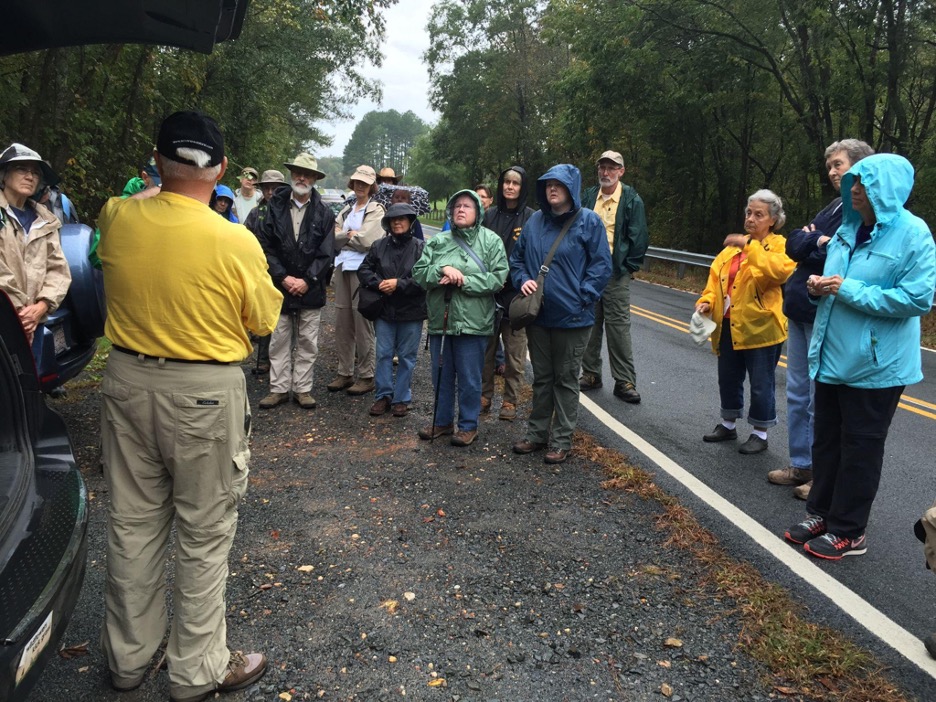Do we have a chance to protect these special places? Dr. Mellichamp said, “We have to try harder.“ He had an uncanny knack not too many naturalists have to find rare plants in the wild, many of which are in North Carolina.
Sowing Seeds of Wonder and Knowledge, by Roxanne Newton
Sharing the World of Plants with People, by Theresa Morr
A Fearless Wildflower Hike Leader, by Carol Fox
Protecting A Jewel of Biodiversity, by Mary Stauble
Sowing Seeds of Wonder and Knowledge
By Roxanne Newton
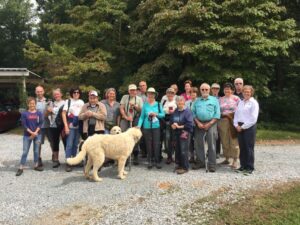
Larry Mellichamp was a rare species of human—a passionate scientist with many significant contributions in his field; a generous, humble colleague who shared credit freely and collaborated widely; a dedicated academic who made science accessible, practical, and fun for home gardeners and plant enthusiasts; and a uniquely gifted teacher who engaged students, supported their learning, and fostered active, lifelong discovery and environmental responsibility.
Perhaps even more important, Dr. M quietly and persistently devoted his life to living and teaching the highest principles and practices of ecology, helping to restore our planet—one plant and one person at a time.
Even before I had the good fortune to meet Dr. Mellichamp, his expansive knowledge and immense vision influenced and enhanced my life in myriad ways. His life’s work not only informed my practice as a gardener, it also brought much joy, learning, and solace to my life—and to the lives of countless others—through his involvement with the creation of the University of North Carolina Charlotte Botanical Gardens. Time spent in Van Landingham Glen and the McMillan Greenhouse lifted my spirits when, as a married mother of young children, I commuted to UNCC for my Bachelor of Arts degree and Master of Arts degree.Years later, as a UNCC employee, I daily sought the wonder and peace of the Botanical Gardens.
Today I continue to marvel at Dr. M’s commitment to creating these essential natural spaces, just one part of his significant legacy to people and plants.
As a member of the Southern Piedmont Chapter of the NC Native Plant Society, I was delighted to have occasions to learn from Dr. M in informal workshops, talks, conversations, and plant sales. After I retired in 2018, I wanted to learn more, so I began taking Native Plant Studies courses. I relished the opportunity to learn from Dr. M, a person I had long admired as a botanist, as an author, and as the architect of the Gardens that meant so much to me.
After my first class with Dr. M, I attended many workshops, talks, and classes that he taught at UNCC, Wing Haven, and the NC Native Plant Society, among others. I bought all his books, even the 1983 out-of-print Practical Botany that he co-authored. I loved to hear him talk about the characteristics of any plant, sharing his wealth of knowledge but also his obvious appreciation for its distinct qualities. I smiled every time that Dr. M would make an important point, pause, and then say, “Write that down.” I was already eagerly writing down everything he said, but as a former teacher, I admired his awareness of this simple but powerful technique.
His unfailing honesty, humor, passion, and expertise as a teacher were exemplary, but Dr. M’s greatest gifts were motivated by his dual commitment to plants and people. He insisted that there were no “dumb questions” and met each person at their level of understanding, making learning possible for all. Even more, Dr. M inspired people to become lifelong students of botany and nature, instilling a boundless capacity for wonder, discovery, and knowledge. What could be a better result of teaching? Dr. M’s lessons will be propagated endlessly as his students grow and share their knowledge with others.
Along with everyone who knew and loved him, I grieve the loss of Dr. M in the world. However, I am grateful for and take comfort in knowing that he nurtured so many plants in so many landscapes and sowed so many seeds in the lives of so many people. If we can care for them properly, these precious seeds of wonder and knowledge will germinate, take root, and thrive. Then, as did our beloved Dr. M, we too can bloom profusely before producing new generations of seeds to drop into the fertile soil of the world, plant by plant and person by person.
Roxanne Newton, Statesville (NCNPS Southern Piedmont Chapter). NCNPS board member-at-large and chair, NCNPS Membership Committee.
Sharing the World of Plants with People
By Theresa Morr
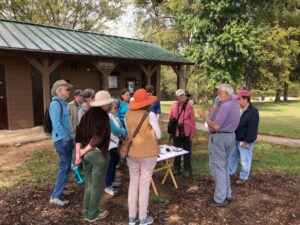
Every time I visit the forest, something I learned from Dr. M. comes to mind – how oak trees are the last in spring to release their pollen and how Bloodroot seeds get planted by ants. I learned how trees are essentially “dead inside,” and it’s the cambium, xylem, phloem and bark layers that sustain them. I can remember my hair standing on end as he described the new-mown grass smell is actually the grass screaming and warning its neighbors as the blades are being decapitated, and laughed when he said that there’s as much sex and violence in the plant world as in anywhere else!
My favorite memory is the Fern Foray trip through several counties, stopping at odd spots along the road to admire unusual ferns, and watching him whack away at the Wineberry bushes with his stick as we walked the trails.
As one of the many who benefited by his generosity and patience in sharing his time and energy and botanical wisdom, I am grateful to have taken his classes, and want to honor his legacy of “sharing the world of plants with people.”
Theresa Morr, Charlotte (NCNPS Southern Piedmont Chapter). NCNPS board secretary.
A Fearless Wildflower Hike Leader
by Carol Fox
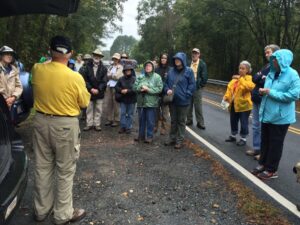
As Southern Piedmont chapter newsletter editor, I could always count on Larry’s creativity when it was time to describe and “market” one of his talks or hikes.
I remember one spring wildflower hike where he said he would lead Southern Piedmont Chapter members to the Grand Canyon of Mecklenburg County. Forty to fifty people signed up for the hike and we wondered how we would accommodate them all. That Sunday morning rolled around and weather forecasters were predicting horrendous storms with possible tornadoes all day long. Terrified hikers dropped out by the droves until a few of us were left.
But Larry was fearless and said that we were going to hike. We met, under high-tension power towers no less, and proceeded to hike the “Grand Canyon” and its wonderful wildflowers. In the end, not a single drop of rain fell on us that day.
Carol Fox, Matthews (NCNPS Southern Piedmont Chapter). NCNPS Southern Piedmont Chapter newsletter editor.
Protecting A Jewel of Biodiversity
By Mary Stauble
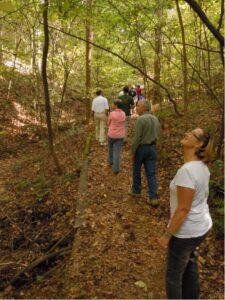
In 1995 the Catawba Wildflower Glen purchased a “ten-acre fragment so outstanding in the number of rare and different species of plant life that the two botanists, Dr. Jim Matthews and Dr. Larry Mellichamp, who had first inventoried it in the early 1990s, immediately pledged a thousand dollars toward its purchase,” according to the Catawba Lands Conservancy. Since then, Larry and Audrey Mellichamp have made another generous gift to the Catawba Lands Conservancy to help preserve the Wildflower Glen.
Later, when I asked Dr. Mellichamp, “Do we have a chance to protect these special places?”, he said we have to try harder. The Catawba Wildflower Glen now contains over 19 acres of purchased land and an additional 26.8 acres in a conservation easement to buffer the property. It was their first land acquisition and a priceless gift of an old-growth forest.
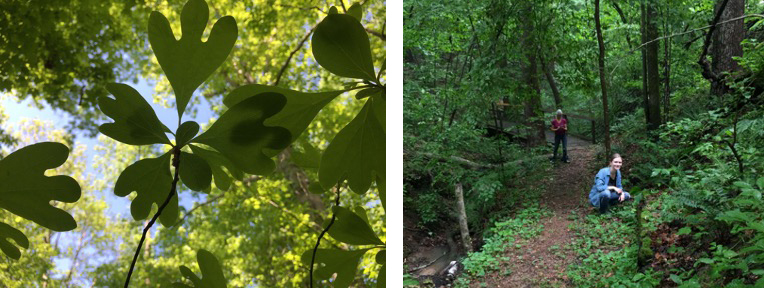
Today over 17,000 acres are conserved by the Catawba Land Conservancy. The Catawba Wildflower Glen is a jewel of biodiversity just below Mountain Island Lake and one of the most botanically diverse pieces of Mecklenburg County, just northwest of downtown Charlotte. Notable characteristics of a mature hardwood forest are the distinctive layers – canopy, subcanopy, shrub understory, and herbaceous groundcover. In early spring, the white flowers of native Bloodroot cover the hillsides. The list of native wildflowers goes on and on with Jack-in-the-pulpit, Catesby’s Trillium, Foamflower, and Windflower. The steep, moist, north-facing slopes along a small creek draining directly into the Catawba River host a rich diversity of herbaceous and woody plant species, including some more common to the mountains, like Mountain Laurel, Horsesugar, turtlehead and Common Silverbell. Due to the sensitive nature of the site, it is open only with permission.
–This article originally appeared in the 2021 Summer Native Plant News
Mary Stauble, Charlotte (NCNPS Southern Piedmont Chapter) is an environmental educator and consultant, and site steward for the Catawba Wildflower Glen.
Articles by Roxanne Newton, Theresa Morr, Carol Fox & Mary Stauble
Native Plant News – Commemorative Edition 2022
